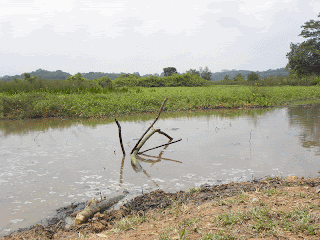NSS Kranji Reservoir Adoption Committee with the aid of NSS members has rolled up their sleeves quite literally (see the pictures and you will know what I mean). Why? They want to keep the marsh more marshy.
The current indicators like the African tulip tree growing near the PUB station show that the pond is drying up. Put simply, the pond is covered with wild vegetation like Water Bananas (Ludwigia Onagraceae), Water Hyacinth (Eichhornia crassipes), Yellow Burhead (Limnocharis flava) and Simpoh Air (Dillenia suffruticosa). Leaving behind the important patches, the wild vegetation will be carefully cleared to create an open water area conducive to fowl like the Lesser and Wandering Whistling Ducks. The intent is to attract more water birds and preserve the biodiversity of the area.
Works have been on for a few weeks now.
Beating the warm Sun on the morning of 13th September, few Nature Society members – Dr. Hua Chew, Kwok Peng, Allen, Wong Cheong and Anuj (me) were at the marsh to check the progressing work and prepare conducive perches at the pond. Dead branches of strong and durable Acacia wood are ideal for this task. Hopefully they would look naturally positioned in the pond.
We spotted some dead branches in the surrounding woodland but it was no easy task to transport them to the pond since the branches were pretty big. Imagine carrying a few of these for over a kilometer. Tiring isn’t it?
The current indicators like the African tulip tree growing near the PUB station show that the pond is drying up. Put simply, the pond is covered with wild vegetation like Water Bananas (Ludwigia Onagraceae), Water Hyacinth (Eichhornia crassipes), Yellow Burhead (Limnocharis flava) and Simpoh Air (Dillenia suffruticosa). Leaving behind the important patches, the wild vegetation will be carefully cleared to create an open water area conducive to fowl like the Lesser and Wandering Whistling Ducks. The intent is to attract more water birds and preserve the biodiversity of the area.
Works have been on for a few weeks now.
Beating the warm Sun on the morning of 13th September, few Nature Society members – Dr. Hua Chew, Kwok Peng, Allen, Wong Cheong and Anuj (me) were at the marsh to check the progressing work and prepare conducive perches at the pond. Dead branches of strong and durable Acacia wood are ideal for this task. Hopefully they would look naturally positioned in the pond.
We spotted some dead branches in the surrounding woodland but it was no easy task to transport them to the pond since the branches were pretty big. Imagine carrying a few of these for over a kilometer. Tiring isn’t it?
On the way back to the pond, Allen spotted a hornet’s nest on one of the Albizia tree.
We also heard a Greater Coucal (I couldn’t photograph the birds but I saw a pair). http://en.wikipedia.org/wiki/Greater_Coucal
After struggling with the branches, Kwok Peng suggested us to use Hua Chew car as a transport lorry. This saved much energy.
Finally we arrived at the pond.
Adventures are not over yet! Placing these branches in the water was no easy feat again! ‘Roll up your sleeves, fold your pants and prepare to get muddy’. That was the slogan. The more experienced ones lead the way (Dr. Hua Chew & Kwok Peng below).
After some perseverance, the 3 perches were ready for the birds. They look quite natural to me. In the end, I was quite happy with the progress we made.
Perch #1
Perch #2
Perch #3
The next visit to the marsh will tell us whether these perches can stay afloat at the same location. Looking forward for the next visit!








